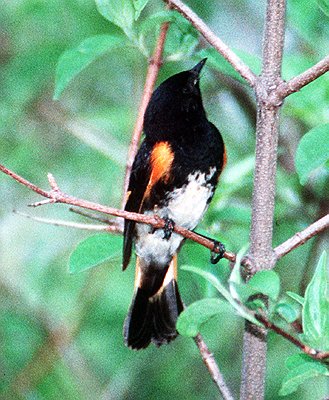|
American Redstart Setophaga ruticilla Candelita,
|
 |
|
Male - Photo: G. Beaton
|
|
American Redstart Setophaga ruticilla Candelita,
|
 |
|
Male - Photo: G. Beaton
|
|
IDENTIFICATION: The male is black with bold orange patches on the wings, sides, and tail. The more commonly seen female and immature birds are gray above and white below, but the orange patches are replaced by yellow. Length: 13 cm.; weight: 7-8 g. VOICE: The call is a sharp "chip" note, which it gives often as it forages; usually sings on the winter grounds only just before departure in April. Audio 3 (M. Oberle). HABITAT: Winters in forests, mangroves, shade coffee plantations, and urban gardens throughout the island. HABITS: The redstart constantly flicks its tail and wings open and closed, as it forages for insects (beetles, flies, lantern flies, and small wasps), spiders, and occasionally fruits. It often snatches insects in mid-air or hovers to pick insects off leaves. It has a relatively wide base to the bill, and stiff bristles around its mouth, like a flycatcher. These features aid in catching insects in mid-air. The redstart is more likely to flycatch for food in Puerto Rico and elsewhere in winter, than on its breeding grounds. In winter the redstart defends a feeding territory, and often returns to the same territory in subsequent winters. It joins mixed-species flocks as they pass through its territory. Females in Puerto Rico are somewhat more likely to inhabit dry forest, in part because older males aggressively defend prime winter feeding grounds against others of their species. Breeds in young deciduous forests or forest clearings in North America. The female builds a cup nest, 10-20 feet high in a tree. For about 12 days the female incubates four white eggs with fine brown spots. STATUS AND CONSERVATION: A common winter visitor. It is threatened on its breeding grounds in North America by cowbird nest parasitism, deforestation, aging of eastern forests, and forest fragmentation. Population declines have been recorded in some regions of North America. RANGE: Breeds in woodlands in much of the eastern USA and southern Canada, west to Oregon and the Yukon Territory. It winters from southern Florida and lowland Mexico south, through Central America and the Caribbean, to northern Peru and Brazil. TAXONOMY: PASSERIFORMES; PARULIDAE |
|
 |
|
|
Female - Photo: G. Beaton
|
 |
|
|
Male - Photo: G. Beaton
|
 |
|
|
Male - Photo: G. Beaton
|
|
References Arendt, W.J. 1992. Status of North American migrant landbirds in the Caribbean region: a summary. Pp. 143-171 in Ecology and conservation of neotropical migrant landbirds (J.M. Hagan III and D.W. Johnston, eds.) Smithsonian Instit. Press, Washington, D.C. Bennett, S.E. 1980. Interspecific competition and the niche of the American Redstart, Setophaga ruticilla, in wintering and breeding communities. Pp. 319-336 in Migrant birds in the Neotropics: ecology, behavior, distribution, and conservation (A. Keast and E.S. Morton, eds.). Smithson. Instit. Press, Washington, D.C. Bent, A.C. 1953. Life histories of North American wood warblers. Smithsonian Instit. U.S. National Museum Bull. 203. (Reprinted by Dover Press, NY, 1963). Cruz, A. 1980. Avian feeding assemblages in Puerto Rico. Carib. J. Sci. 15:21-27. Curson, J., D. Quinn, and D. Beadle. 1994. Warblers of the Americas: an identification guide. Houghton Mifflin, NY. Dunn, J. and K. Garrett. 1997. A field guide to warblers of North America. Houghton Mifflin, NY. Ehrlich, P.R., D.S. Dobkin, and D. Wheye. 1988. The birderís handbook: a field guide to the natural history of North American birds. Simon and Schuster/ Fireside, NY. Faaborg, J. 1982. Avian population fluctuations during drought conditions in Puerto Rico. Wilson Bull. 94(1):20-30. Faaborg, J. and W.J. Arendt. 1984. Population sizes and philopatry of winter resident warblers in Puerto Rico. J. Field Ornithol. 55:376-378. Faaborg, J. and W.J. Arendt. 1992. Long-term declines of winter resident warblers in a Puerto Rican dry forest: which species are in trouble? Pp. 57-63 in Ecology and conservation of neotropical migrant landbirds (J.M. Hagan III and D.W. Johnston, eds.) Smithsonian Instit. Press, Washington, D.C. Holmes, R.T. and T.W. Sherry. 1992. Site fidelity of migratory warblers in temperate breeding and Neotropical wintering areas: implications for population dynamics, habitat selection, and conservation. Pp. 563-575 in Ecology and conservation of neotropical migrant landbirds (J.M. Hagan III and D.W. Johnston, eds.) Smithsonian Instit. Press, Washington, D.C. Marra, P.P., K. A. Hobson, and R. T. Holmes. 1998. Linking winter and summer events in a migratory bird by using stable-carbon isotopes. Science 282:1884-1886. Raffaele, H.A. 1989. A guide to the birds of Puerto Rico and the Virgin Islands. Princeton. Raffaele, H.A. 1989. Una guía a las aves de Puerto Rico y las Islas Vírgenes. Publishing Resources, Inc., Santurce, PR. Raffaele, H.A., J.W. Wiley, O.H. Garrido, A.R. Keith, and J.I. Raffaele. 1998. Guide to the birds of the West Indies. Princeton. Sherry, T.W. and R.T. Holmes. 1997. American Redstart (Setophaga ruticilla). No. 277 in The birds of North America (A. Poole and F. Gill, eds.). Acad. Nat. Sci., Philadelphia, PA, and Am. Ornithol. Union, Washington, D.C. Wunderle, J.M., Jr., and R.B. Waide. 1993. Distribution of overwintering nearctic migrants in the Bahamas and Greater Antilles. Condor 95:904-933. Wunderle, J.M., Jr., and S. C. Latta. 2000. Winter site fidelity of nearctic migrants in shade coffee plantations of different sizes in the Dominican Republic. Auk 117(3):596-614. American Redstart, Spanish text Next related species in taxonomic order Previous related species in taxonomic order |
|